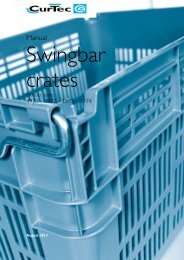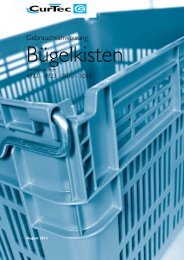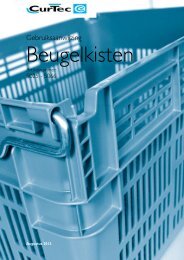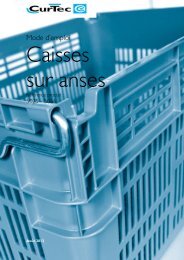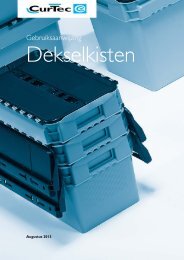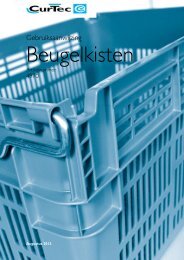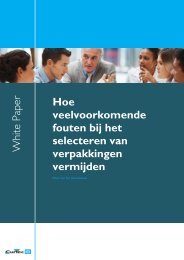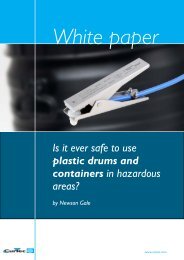Click Pack
Click Pack - CurTec
Click Pack - CurTec
Create successful ePaper yourself
Turn your PDF publications into a flip-book with our unique Google optimized e-Paper software.
Manual<strong>Click</strong> <strong>Pack</strong>April 2014
WashingThe washing instructions below apply to the cleaning of all CurTecpackaging products that are made of polyethylene andpolypropylene.• Best results will be achieved with a washing installation that isequipped with spray nozzles or a so-called Ultra-Sonicinstallation.• Best qualified detergent is a low-foaming alkaline substance with aPH-value of 10 to 12 (solvents.)• The recommended temperature of the washing water liesbetween 40°C and 50°C.• The temperature of the rinsing water can only be up to 65°C.• Washing at maximum temperature can only take up to 35seconds and rinsing at maximum temperature only up to 20seconds. It prevents the plastic from warming up and shrinking.• Increased drying of products can be effected by means ofapplying cold air. If warm air will be used the drying can only lastup to 30 seconds at a maximum temperature of 65°C.• The blowing and drying part of the installation needs to beadjusted to the product, so those difficult spots of the kegs canalso be dried.• For specific technical information CurTec would like to refer tothe various suppliers of washing installations.Attention! Check the thermostat and programmed times of yourequipment regularly.1201
1 CloseA rubber mat (red) simplifies opening and closing and reduces theclosing force1. Place the container on a rubber mat and ensure that the top is ata comfortable working height. Lift the lid and place on the container.2. Position the lid by turning it a little counter clockwise until it dropsinto position over the quarter turn threads. Listen and feel for whenthe lid drops in place.3. Rotate the lid firmly 90 degrees in a clockwise direction to closeon the quarter turn threads. This can be done in one operation.Press downwards while rotating the lid until the lid locates over thebutton. Listen for a click as the lid passes over the button. The lid isnow closed.<strong>Click</strong> <strong>Pack</strong> manual 1201
4. After closing the container you can make the container tamperevident. For that purpose the handgrip opposite to the handgripwith the locking button has a loop.5. Push the special sealing pin into the loop until it locks. You can olyseal containers with product codes 45XX with these sealing pins.6. The container is now sealed.For <strong>Click</strong> <strong>Pack</strong> with product code 44XX you can also use a sealingstrip. CurTec advises to use Unisto Compact Seals but you canofcourse use any other strip you prefer. Just make sure that theyhave a tail with a minimum length of 225 mm and a maximumdiametre of 2 mm.7. Put the tail of the sealing strip in a sealing loop and pull it down.Push the end through the eye of the strip and pull tight.<strong>Click</strong> <strong>Pack</strong> manual 1201
9. The container is now sealed.Contrary to sealing using a pin, which is only possible on thehandgrip with a dedicated loop, you can use a sealing strip on allfour handgrips.<strong>Click</strong> <strong>Pack</strong> manual 1201
02 OpenA rubber mat (red) simplifies opening and closing and reduces theclosing force1. To break the seal lift the pin gently with your index-finger andsqueeze until the tip breaks off. The foot will remain in the loop andcan be removed separately.2. The container can be opened. To remove the lid hold it firmlywith both hands opposite each other and press the button with onefinger.3. Turn the lid firmly 90° in an counter-clockwise direction with bothhands while applying a downward pressure.<strong>Click</strong> <strong>Pack</strong> manual 1201
03 Use1. Filling temperatureThe maximum filling temperature of the contents is 80°C. Thecontents must have cooled to 30°C before the <strong>Click</strong> <strong>Pack</strong> can beclosed and stacked. This prevents vaccuum formation.2. Filling levelThe lid of a <strong>Click</strong> <strong>Pack</strong> slides partly into the container. Thereforealways fill the container to a maximum of 2 cm below the rim.3. EmptyingOpen the container following instruction no. 2. Use the rim or thespecial pouring grip and the base to tip the container and pour outthe contents.4. LiftingA <strong>Click</strong> <strong>Pack</strong> can be easily lifted and moved both mechanically andmanually. Use the specially developed handles which have beenpositioned opposite each other on the container. Consider the HSEregulations regarding weight and frequency restrictions for lifting.<strong>Click</strong> <strong>Pack</strong> manual 1201
5. Freezing<strong>Click</strong> <strong>Pack</strong> is manufactured from both PP and HDPE and resistant totemperatures down to -18°C. Shock load on the containers must beavoided at temperatures below -5°C.6. Air transportCurTec recommends shipment in pressurized cargo holds for airtransport of packaging. We cannot guarantee optimal or correctperformance if packaging is shipped in cargo holds without pressureregulation. Due to differences in air pressure, a packaging can startto breath.All depends on duration of transport, filling level, type of contentand the way of packing and palletising.We advise to test each packing and shipping mode prior todispatch.<strong>Click</strong> <strong>Pack</strong> manual 1201
04 Static loadWhen stacking the <strong>Click</strong> <strong>Pack</strong>s for storage in e.g. a warehouse orcold store it is important to know what the maximum stacking loadcan be on the bottom container. The stacking load depends stronglyon: the container weight, the number of containers to be stacked,the weight of interlayers and pallets, surrounding temperature, theduration of the load and the surface beneath the bottom containers.T (°C) t (months)Product code4406 4415 4420 4515 4520 45250 0,5 288 329 329 315 315 3150 2 242 277 277 285 285 2850 6 221 241 241 265 265 2650 12 193 221 221 240 240 24015 0,5 187 214 214 240 240 24015 2 157 180 180 220 220 22015 6 137 157 157 205 205 20515 12 126 144 144 190 190 19025 0,5 140 160 160 200 200 20025 2 118 135 135 185 185 18525 6 103 117 117 165 165 16525 12 95 108 108 150 150 15035 0,5 105 120 120 165 165 16535 2 95 101 101 150 150 15035 6 77 88 88 120 120 120The table shows for each <strong>Click</strong> <strong>Pack</strong> the maximum stacking load (inkg) at a given surrounding temperature during a certain period oftime placed on a flat and closed surface or pallet.Attention! The loads mentioned in the table can only serve as indications.CurTec always advises its customers to perform additional testing.On the basis of the table the number of containers that may bestacked can be calculated. It is the stacking load mentioned reducedby the carrying part of the pallet’s interlayers, divided by thecontainer weight. This number, with figures behind the commasmaller than eight, rounded off + 1 = total number of <strong>Click</strong> <strong>Pack</strong>s.<strong>Click</strong> <strong>Pack</strong> manual 1404
In case of an unspecific time or temperature please look in the nextappropriate column. If you want to know what the stacking load iswith shorter periods of time, the table in instruction 5 Dynamicload can be of service.Before stacking the kegs the temperature of the contents must equalor be lower than the surrounding temperature.The maximum stacking time is reduced considerably at atemperature higher than 35°C. The stacking load in the tableamounts at 50°C to only 75% of the value last mentioned and at atemperature of 60°C to only 50%.In case a stack is higher than 2.5 metres the floor angle cannot bemore than 0.5%.At the transit of one transport form to another, from storage totransport or from transport to storage, the bottom containers mustbe placed highest in the new stack.We advise users to test each new packaging method upfront.<strong>Click</strong> <strong>Pack</strong> manual 1404
05 Dynamic loadBefore stacking the <strong>Click</strong> <strong>Pack</strong>s for transport it is important to knowwhat the maximum stacking load on the bottom container of thestack is. With transport this stacking load is called dynamic load.ProductcodeT (in °C) 5 5 5 5 30 30 30 30 40 40 40t (weeks) 0.5 1 3 5 0.5 1 3 5 0.5 1 34406 a 246 225 196 184 120 110 96 90 90 82 72b 177 162 142 133 86 79 69 65 65 59 52c 160 146 128 120 78 71 62 58 58 53 47d 106 98 85 80 52 48 41 39 39 36 314415 a 263 241 210 197 128 118 102 96 96 88 77b 190 174 152 143 93 85 74 69 69 64 56c 171 157 137 128 83 76 67 62 62 57 50d 114 105 91 86 56 51 44 42 42 38 334420 a 263 241 210 197 128 118 102 96 96 88 77b 190 174 152 143 93 85 74 69 69 64 56c 171 157 137 128 83 76 67 62 62 57 50d 114 105 91 86 56 51 44 42 42 38 334515 a 242 223 204 196 154 142 135 127 123 100 92b 175 161 147 142 111 103 97 92 89 72 67c 158 145 133 128 100 93 88 83 80 65 60d 105 97 88 85 67 62 58 55 53 43 404520 a 242 223 204 196 154 142 135 127 123 100 92b 175 161 147 142 111 103 97 92 89 72 67c 158 145 133 128 100 93 88 83 80 65 60d 105 97 88 85 67 62 58 55 53 43 404525 a 242 223 204 196 154 142 135 127 123 100 92b 175 161 147 142 111 103 97 92 89 72 67c 158 145 133 128 100 93 88 83 80 65 60d 105 97 88 85 67 62 58 55 53 43 40a =b =c =d =transport by watertransport by railtransport by roadtransport by airThe load mentioned in the table depends strongly on thetemperature and time indicated: 5°C is the temperature for cooledtransport, 30°C is the temperature for the average transport byroad or inland waterways and 40°C is the temperature for transportin warmer surroundings. In case of an unspecific time or<strong>Click</strong> <strong>Pack</strong> manual 1404
temperature, below 40°C, please look in the next appropriatecolumn. In case the temperature rises even more, please be awarethat at 50°C the load can only be 75% and at 60°C only 50% of theload at 40°C.Attention! The loads mentioned in the table can only serve as indications.On the basis of the table the number of containers that may bestacked can be calculated. It is the stacking load mentioned dividedby the product of the keg weight and the relevant safety factor. Thisnumber, with figures behind the comma smaller than eight, roundedoff + 1 = total number of containers.At the transit of one transport form to another, from storage totransport or from transport to storage, the bottom containers mustbe placed highest in the new stack.The containers must by stowed professionally and fixed in a waythat makes shifting impossible.For the use of pallets check instruction 6 Palletisation.For stacking and storing in a warehouse check instruction 4 Staticload.We advise users to test each new packaging method upfront.<strong>Click</strong> <strong>Pack</strong> manual 1404
06 Palletisation1. PalletA pallet must have an almost closed surface fitted with planks nomore than 5 cm apart. In case a pallet is placed on top of a <strong>Click</strong><strong>Pack</strong> pallet, the surface needs to be flat and solid to avoid pressurepoints on the top layer.2. FormationCurTec advises to place the filled containers on a pallet as follows:Europallet 80 x 120 cm440612 pcs per layer4415 - 44208 pcs per layer4500 series6 pcs per layer100 x 120 cm/ 40 x 48”440618 pcs per layer4415 - 442010 pcs per layer4500 series9 pcs per layer<strong>Click</strong> <strong>Pack</strong> manual 1404
3. StackingFilled containers are placed on a flat surface and stacked by placingthe base of the container in the counter shape of the lid.In case a pallet is placed on top of another pallet, the surface needsto be flat and solid to avoid pressure points on the top layer.Attention! The total load on the bottom container of a stack may neverexceed the maximum loads as indicated in the tables of instructions 4and 5.When positioning the <strong>Click</strong> <strong>Pack</strong>s on a pallet it is important to turn thehandgrips away from the pallet corners to avoid damaging the shrinkwrapor the stretch foil.4. <strong>Pack</strong>ingWe recommend the use of a shrink wrap which needs to be shrunkaround the pallet as well. In addition, the bottom of the pallet needsto be stretched with foil as well. The containers at the base of astack will carry most of the load and to avoid a collapse they cannotbe deformed by overstretching the foil or over-heating the wrap.5. Pallet handlingFrom a safety point of view CurTec recommends the transport ofone pallet at a time. In order not to disturb the stack the fork of thelift truck needs to be kept almost horizontal.<strong>Click</strong> <strong>Pack</strong> manual 1404
CurTec InternationalSpoorlaan Noord 925121 WX RijenThe NetherlandsUK & Ireland: +44 20 3514 4624North America: +1 908 450 98 16All other countries: +31 88 808 2000curtec.en@curtec.comwww.curtec.comHIGH PERFORMANCE PACKAGING



